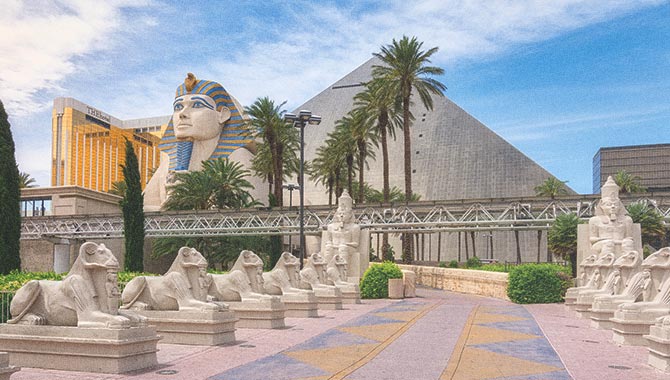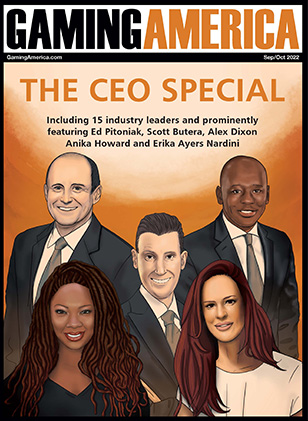
When you talk to executives and customers in Las Vegas they will tell you, with near ubiquity, that it is all about the experience.
Las Vegas is ground zero in the fusion of customer-centric development and strategic marketing; the casinos were selling the same product, but the consumption (and attracting the specified customers) was determined by placemaking. The customers interpret this as the experience, and positive experiences lead to the desire to repeat them, thus engendering loyalty.
In the 60-year history of Las Vegas there are many landmarks in charting the evolution of experimental design within the customer experience: from Caesars Palace to The Cosmopolitan, customers have been taken on journeys of escapism, aspiration and fantasy. Perhaps no story is more instructive in understanding the failure of strategic thinking and poor decision-making than that of Luxor.
Circus Tents, Castles and a Paddle Steamer
As the decade moved from the 1980s to 1990s, there was no doubt that Circus Circus Enterprises was the dominant casino corporation in Nevada. The leadership duo of Bill Bennett and Bill Pennington had proved formidable, shifting Jay Sarno’s Circus Circus from the most radical, but loss-making, casino to ever open in Las Vegas to the basis of a $15 per share, $300m IPO in 1983.
Under their lead, Circus Circus Enterprises grew to a regional giant, acquiring and operating casinos in Las Vegas, Reno and expanding The Edgewater and paddle steamer inspired Colorado Belle in Laughlin. In 1991, the company produced gross revenues of $620m, with a market-leading operating margin of over 30%. The share price was over $60.
The unprecedented success of this company was due to the operational and management capabilities of CEO Bennett, a ruthless controller of costs, who had assumed primary control of company by the decade’s turn.
Bennett had always surrounded himself with smart guys. From Mel Larson and Mike Ensign to Clyde Turner, Bill Paulos and Glenn Schaffer, and many more in-between. This relatively small leadership cadre achieved tremendous success in shaping the casino industry.
Although Steve Wynn beat him to the opening punch with The Mirage, Bennett’s first ground-up development in Las Vegas – Exalibur – opened its doors in summer of 1990.
Pete Earley, in his book “Supercasino,” observed: “During its first year, the Excalibur became the most profitable Circus Circus casino. It had cost $300m to build and it earned $80m before taxes, netting as 26.6% return.”
After Excalibur’s success, Bill Bennett announced his retirement. Shortly after. however, he recanted this decision.
Project X – The Greatest Pyramid Ever Built
What prompted Bennett’s change of mind? Was it Steve Wynn announcing Treasure Island to compete squarely on his turf, was it a conflict with his lieutenants that had patiently waited for his retirement to assume the mantle, or was it that he still had unsated ambition?
Perhaps all of the above were in consideration when Bennett announced Project X, a pyramid-shaped casino resort to be designed by Veldon Simpson and built by Perini on land adjacent to Excalibur.
Everything that Bennett had learned from his career was funneled into this property and everything inside was experiential. The Luxor was to be the peak of the genre of themed properties.
The exterior set the scene.
The black glass pyramid is striking enough, but at full power, the 42.3 billion candela beam could be seen from 275 miles away.
Inside, the focus on a narrative experience was evident throughout.
Restaurants, including the Winds of The Gods dinner show, were Egyptian themed, as were staff uniforms, carpets, statues and the hand-painted hieroglyphics, which were prominent throughout the property.
Executives planned the experience-based journey in great detail, bringing in movie director and special effects guru Douglas Trumbull to create 3-D movies, theater and simulators to suit the narrative. SEGA’s entertainment center included the latest games and activities, and 'Jody and Elias', animatronic camels who chatted at passing guests.
Simpson’s architecture included unique features, with 'River Nile' waterways, inclinators up the sides of the structure and narrow declining walkways to evoke the journey taken by Howard Carter in his archeological discovery of Tutankhamen’s tomb.
The resort opened with 2,524 rooms encased in the main structure. Outside, the landscaping included over 100 fountains, with a sound and light show, featuring video projections on the water, and laser beams shooting from the giant Sphinx that guarded the entrance. From top to bottom, this was carefully considered and crafted to be the most ambitious experiential property in the world.
At 6.45 pm on October 14th, 1993, William G Bennett flicked the switch. The iconic pillar of white light filled the sky, marking the Luxor open to invited guests, with the public entering the next day.
However, by January 1994, not all was looking so promising at Circus Circus Enterprises. The Luxor was beset with operational challenges stemming from the unique and unproven design of the property, compounded by the constant challenge to control costs.
The backlash proved costly for Bennett, and on July 9th, 1994 he resigned and departed Circus Circus Enterprises. That year, companywide, Circus Circus Enterprises generated almost $1bn in revenues.
The Luxor cost $380m to build, generated profits of $90m in year one and $86m in year two. It ran at over 90% occupancy.
After Bennett’s departure, Luxor saw significant further investment in renovation and expansion, with over 2,000 additional rooms and an increase of amenities at a cost of over $625m in total, but the company’s focus had moved on.
In 1998, Wynn’s Bellagio elevated the resort experience, proving that luxury resorts could generate superior revenues, in both gaming and non-gaming, bringing increasingly affluent customers to Las Vegas. The year 1999 saw Sheldon Adelson’s Venetian and The Mandalay Bay open. The latter marked the end of the Circus Circus heritage and Bennett’s middle-class experiential model. Instead the paradigm was aligning with the emerging convention and wealthier customer that was discovering Las Vegas. To mark their new flagship, management took the decision to rebrand Circus Circus Enterprises as The Mandalay Resort Group.
The Luxor Paradox
Luxor, Treasure Island and The MGM Grand all opened in Quarter 4 of 1993. All saw families as a core customer segment and were experience-driven, but none to the extent of Luxor.
These resorts had a significant impact to the growth of Las Vegas but there was a glaring problem.
Between 1992 and 1994 visitation was up by 29%, room inventory by 16%; in Clark County (where the Strip is located) gaming revenue was up by 24%, but Strip gaming revenue was down per person by 4%. More people were coming to Las Vegas, but on average, they were gambling less; this huge investment was not luring gamblers to the casino!
In truth, Circus Circus Enterprises had never attracted high-rollers to their properties, despite expectations that Luxor would compete against The Mirage for such customers.
Looking through the telescope of gaming revenue, the Luxor gamble did not pay off, but, with a wider lens, in terms of popularity and non-gaming visitation, it was transformative.
After MGM Resorts’ $7.9bn acquisition of the company in 2005, many of the old Mandalay executives were replaced by younger, more corporate management teams.
Incoming Luxor President, the late Felix Rappaport, said in 2007: “We’re not a British museum with ancient artifacts, we’re a casino-resort.”
Under Rappaport’s leadership, the Egyptian theme was gutted. Hieroglyphics became history.
The atrium, once packed with attractions, saw bars, restaurants, lounges and entertainment venues supplanting them. Lobby bar, Nefertiti’s became Aurora. LAX nightclub opened (as the nightclub crowd discovered Las Vegas), alongside cocktail bars Noir, Flight and Liquidity.
Even still, a former Executive, present at the time of the renovations, told me, “Whatever you do inside, or however you try and market it, it’s a big, black pyramid in the middle of the desert.”
MGM Resorts spent $300m on de-theming Luxor, equating to 80% of the original construction budget.
Lessons From Luxor
Management decisions left Luxor stranded in the desert, hidden between the exterior’s promise of escape and fantasy, inside delivering just another casino chasing the latest customer fad. It became the premier victim of the homogeneity found in this period of casino management.
This aspect of managerial thinking has been proven a failure as prevailing practice has moved from managing individual assets to a broader holistic market with segmentation and customer offering more nuanced, with a reversion to creating a variety of experiences.
True, 'themed' properties were not a driver for visitation in their own right, but in a market that has over 150,000 hotel rooms, the ability to differentiate between products remains of value.
Compare the performance of the properties that retained their experiential offering - Caesars Palace, Circus Circus, Excalibur, Paris and New York New York - versus those that eliminated them - The Mirage, Rio, Monte Carlo and Luxor. With hindsight, was there a proven investment case to de-theming?
Today, nearly 30 years from Luxor opening and after 18 years of MGM’s ownership, the prevailing strategic thinking is in driving multiple visitation metrics to provide an appropriate revenue related to the customer, and today’s customer is younger and seeking more than gaming, if gaming at all. When developing resorts, operators need to think far more strategically in meeting the needs of their customers, emotionally as well as functionally. In this respect, Luxor was decades ahead of its time.
To recapitulate, when you talk to executives and customers in Las Vegas they will tell you, with near ubiquity, that it is all about the experience. Like the beacon atop the Luxor, Bill Bennett’s light is still visible to all that care to study his legacy.

